
NEWS
-
Summary of the Local Briefings (Nov. 9–13) Has Been Released
-
Prefectural Office Avenue Social Experiment (Phase 2) was held.
-
The results of the local workshop have been announced.
-
Prefectural Office Avenue Social Experiment (Phase 1) was held.
-
The video of the International Competition Symposium has been posted.
-
A local workshop was held.
-
The International Competition Symposium was held.
-
Proceedings, including evaluation-related content from the 1st to the 4th Judging Committee meetings, have been published.
-
The results of the second round have been announced.
-
Submission for second screening has been closed.
-
Notice of Public Presentation has been closed.
-
The submission form for the second screening has been released.
-
The call for opinions at the public exhibition has ended.
-
We have announced the works that passed the first screening.
-
The declaration of participation and submission for first screening has been closed.
-
「Competition site introduction video」 has been posted.
-
Submission of Preliminary Application has been closed.
The submission form for the first screening has been released. -
The Q&A document has been updated.
-
「Frequently asked questions Q&A」 has been posted.
-
The Q&A document has been updated.
-
The Q&A document has been updated. In line with this, the application guidelines have been partially revised.
-
Questions are closed
-
「Reference Templates ENG」and 「Reference Supplementary Materials ENG」 has been posted.
-
「Reference ENG」 has been posted.
-
A collection of questions and answers has been published. In line with this, recruitment guidelines P.10, Form 4-1We have revised some of the.
-
Gunma Prefecture's attractive video 「Innovate in GUNMA with us」 has been posted.
-
Public announcement has started. Recruitment requirements have been posted.
-
The special website has been released! The detailed application guidelines will be released soon.

Second round results
The competition received 13 submissions (from 44 individuals in 13 groups), of which 5 submissions passed primary screening.
Following strict review by the Judging Committee based on the secondary proposals and the public presentation held on March 22, a Grand Prize winner, a Runner-Up winner, and selected entries were determined, as follows.
(We request that viewers refrain from screenshots, reproduction, or secondary use of the works submitted for secondary screening.)
Grand Prize Winner
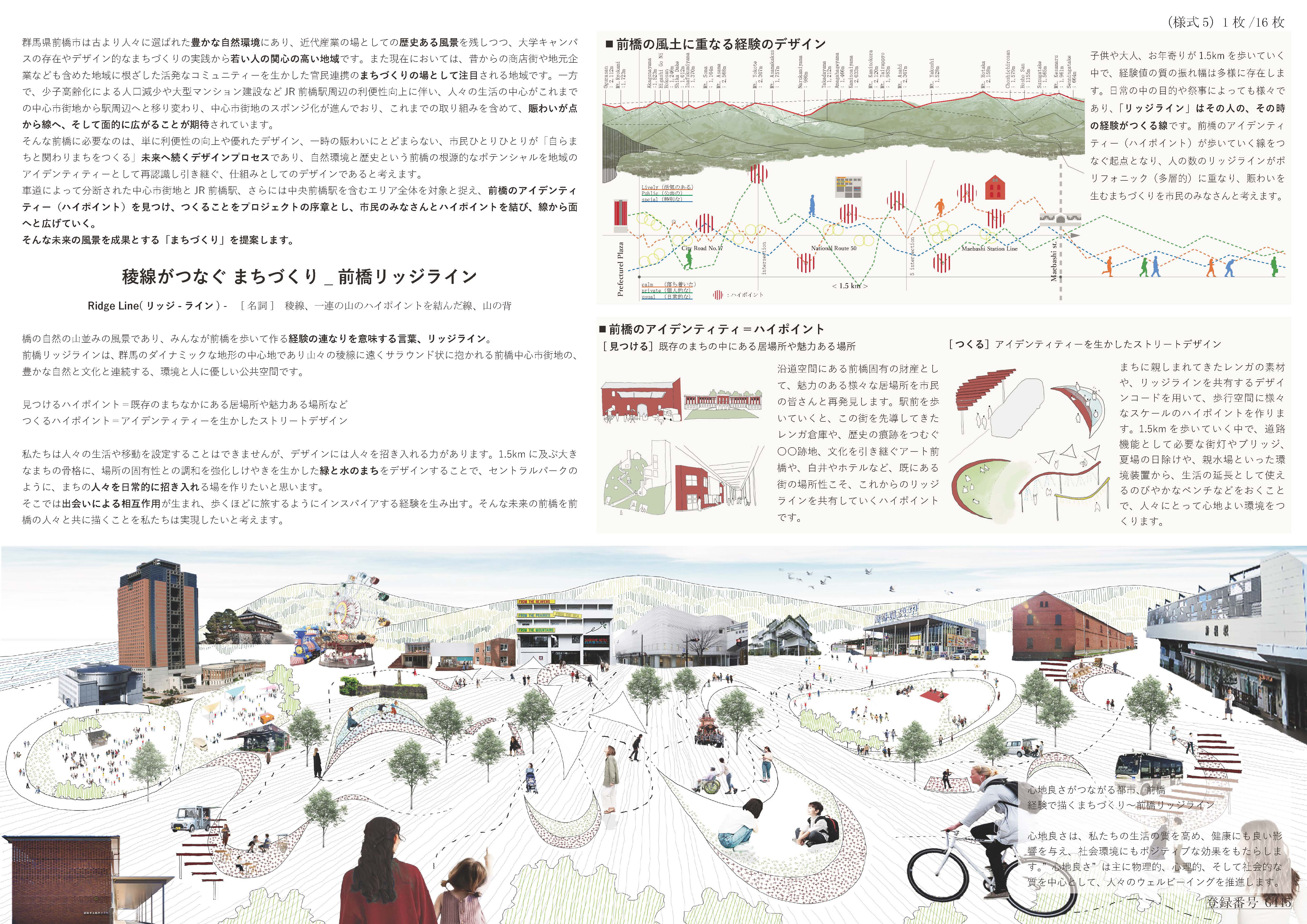
- Theme of the work
- Urban Planning Connected by Mountain Ridges – Maebashi Ridge Line
- Team submitting proposal
- Registration number:G445
Representative:MOUNT FUJI ARCHITECTS STUDIO
Members:①WALLACE ROBERTS & TODD LLC②SYSTEMATICA③Fukken Gijyutsu Consultants Co.,Ltd④SANYO GIJUTSU CONSULTANTS K.K. - Score
- 77 points
- Public presentation video
Runner-up Winner
Selected entries
(Selected entries are listed in order of registration number.)

- Theme of the work
- Connecting the City through Streets
- Team submitting proposal
- Registration number:G423
Representative:studio on site.
Members:①Nihonkai Consultant Co.,LTD.②KAP Co., Ltd.③Illumination Of City Environment④U M A / design farm
- Public presentation video
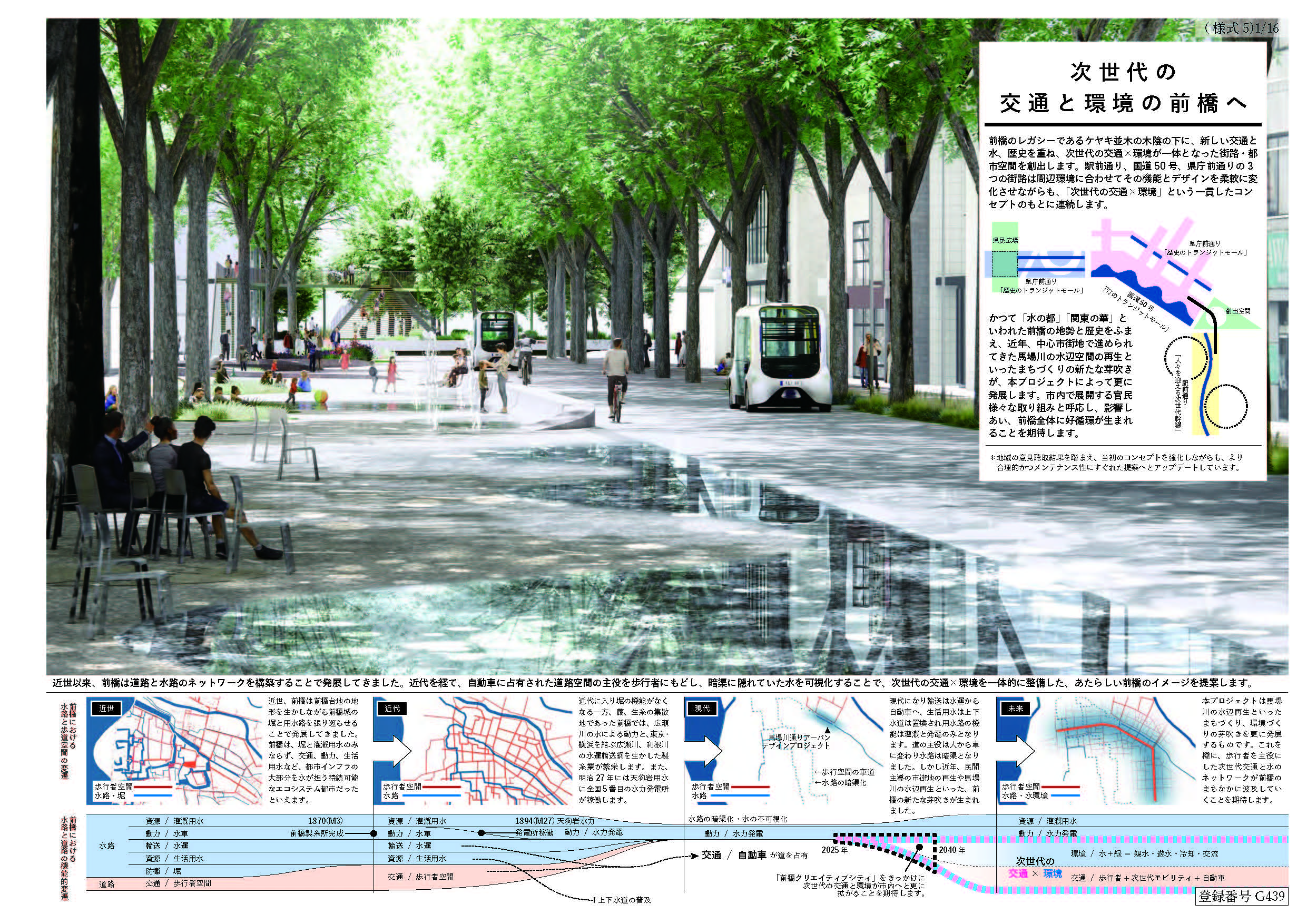
- Theme of the work
- Toward a Next-Generation Environment and Transportation in Maebashi
- Team submitting proposal
- Registration number:G439
Representative:AS inc.
Members:①HATO Eiji②Infras③Research Architects Architectural Design Office④FUKKEN CO.,LTD.
- Public presentation video
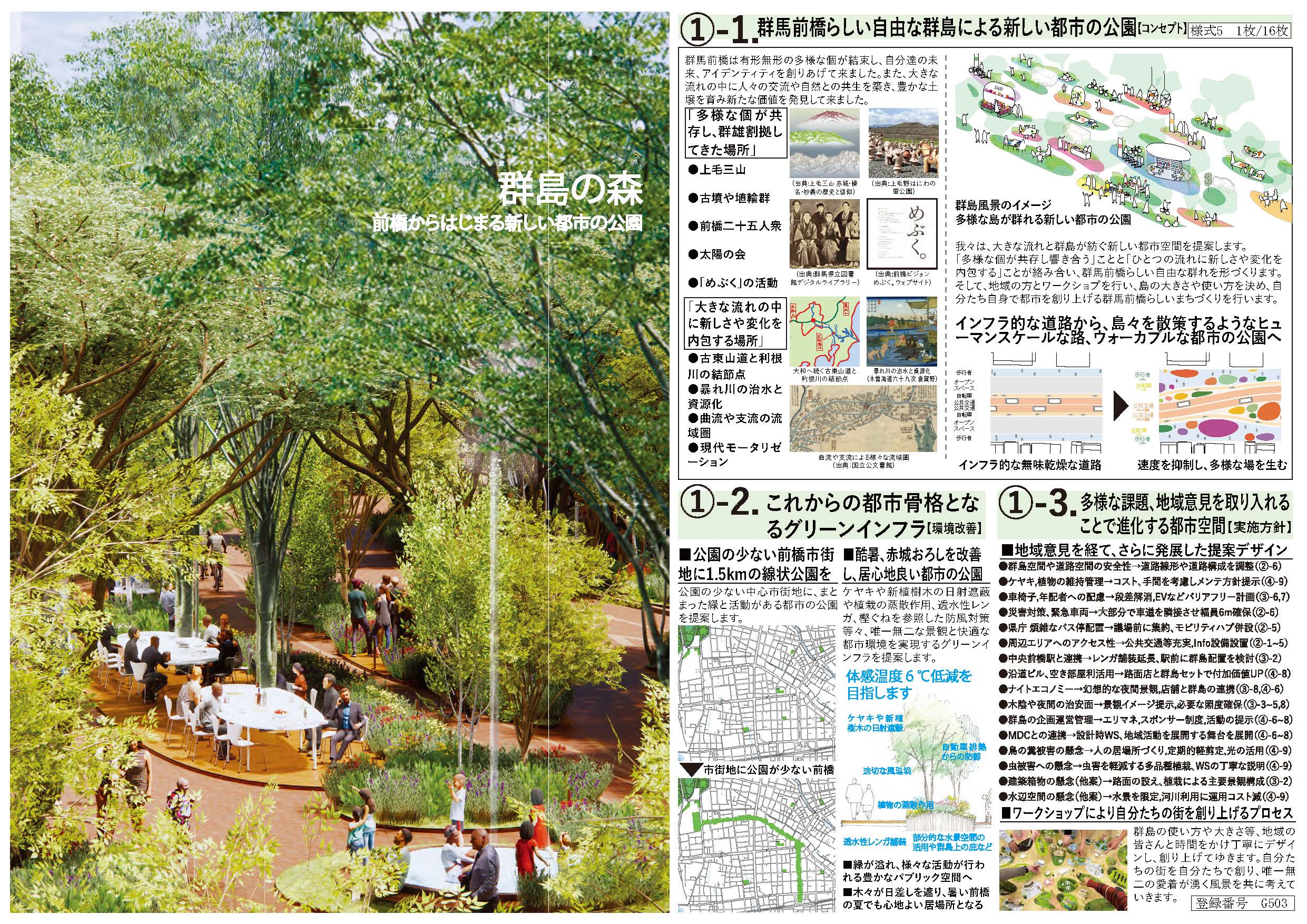
- Theme of the work
- The Archipelago Forest – A New Urban Park Originating in Maebashi
- Team submitting proposal
- Registration number:G503
Representative:Sou Fujimoto Architects
Members:①E-DESIGN Inc.②Nippon Koei Urban Space Co., Ltd.
- Public presentation video
Judges’ comments
"Click here for comments including details of the project so far."
The following are excerpts from the individual comments of the judges.
※In addition, due to circumstances, Commissioner Nishimura (Vice-Chairman) was absent from the second round of screening.
Yo Sasaki, Committee Chair
I am pleased to report that the selection process has come to a close. From the results, I believe that the winning works and the competition overall will deliver a powerful message about the ever greater endeavors that will launch from Maebashi. I would like to express my gratitude to the organizers and to the applicants for their great efforts along the long and difficult path leading to this point.
The scopes and the time frames of the selected designs vary greatly. While we consider whether the competition's given design conditions are realistic ones, we must at the same time question the feasibility of this endeavor not as a competition of ideas or proposals but as a competition premised on implementable design. Putting together the application guidelines was a daunting task. The unprecedented prize money and the international nature of the competition, matters that had already been decided, further raised the difficulty of envisioning and responding to all possible situations. The duties of the Judging Committee included creating the application guidelines. The competition has been certified as appropriate in accordance with the civil engineering design competition guidelines of the Japan Society of Civil Engineers. That organization's Public Design Competition Study Subcommittee, under the Construction Management Committee, ably assisted us in the process leading to certification.
After working through the process and finally commencing recruitment in October of last year, we passed the baton to the applicants, who poured immense energy into their works. Details of the primary screening process are left to the report by the organizer. Here, I would like to provide general comments on the public presentations and on the five works subjected to secondary screening. I invite everyone to view these comments together with commentary by individual Judging Committee members.
Public presentations were a critical process within the competition. Despite limits on time, the presentations allowed judges to examine matters not explicit in the submitted materials and to affirm the approaches of the presenters through impassioned narratives, finely detailed models, prepared videos, and Q&A sessions. A number of the Judging Committee members reported that the presentations led them to update preliminary evaluations that they had made based on submitted materials alone.
In the screening following the presentations, the judges exchanged opinions on the five proposals and conducted scoring in a predetermined format. The scoring left proposals G445 and G758 tied for first place ahead of the others, turning the discussion toward which of the two to select as the winner. While both proposals were outstanding, the judges agreed that G445 left a stronger message and sense of expectation as a proposal able to undertake its endeavor with the interest and cooperation of stakeholders and citizens. Judging also considered the diversity of proposing teams as sending a vital message. Below are comments on the works by Committee Chair Sasaki, touching on discussions in the Judging Committee.
Grand Prize Winner G445
While the concept of the proposal was evident from the submitted materials, details of the specific space proposal and the plans for proceeding were made clearer in the public presentation and yielded new points for evaluation. The proposal was rated highly for its aim of seeking a globally communicable design, using Maebashi’s streets to express the power visible today in the city and the assets unique to it, including the mountains seen in the distance. The modeling skills of the team were evident in its proposal for well-designed street areas, a citizens' square, and the existing five-way intersection. At the same time, concerns about the need for a bridge-shaped structure and the feasibility of traffic management premised on a smart traffic signal system were noted. However, taking into consideration the plan's process for determining forms through dialogue with citizens and its sense of challenge that meshes with the competition's aims, the proposal was deemed the Grand Prize winner.
Runner-Up G758
This proposal was rated a solid plan for the comprehensiveness of its perspective and the depth of its study, with clearly set goals, proposals that carefully consider local conditions and traffic management, and the framework for advancing the project. The plan also received high marks for its aim of expressing street spaces capable of revealing scenes of everyday life, with connection to the broader landscape and history. At the same time, questions arose concerning the design and function of the proposed citizens' square and cocoon-shaped roof, particularly whether these would hold a unique value not only at present but into the future. The experimental nature of the mobile pots (Self-driving furniture) pose a challenge; operational issues can also be assumed. While the ability of the team to advance projects steadily and flexibly even amid elements of uncertainty was evident, the proposal was deemed to have less of an impact than G445 in terms of a Creative City international competition outcome, and so was awarded Runner-Up status.
Selected Entry G423
This proposal was rated highly for its town hub concept that holds the potential to contribute to urban planning integrated with the roadside, as well as its detail based on careful research on surrounding area. Its possibilities and feasibility as a core for creating a sense of neighborhood were recognized, even if not for all of the 12 proposed locations. Conversely, the proposal was seen as heavily reliant on louvers, and concerns persisted over management, including of the biotope. A lack of power to communicate an outward-facing message was also noted.
Selected Entry G439
This proposal was evaluated highly for a maturity that had advanced from the level of the preliminary proposal, demonstrating an attentive understanding of Maebashi's history and water systems and considerations of traffic management and of times when water cannot be used at the area specified as waterside. The proposal leaves activities in street spaces to citizens, but its stance of securing maintenance of physical infrastructure through public means was recognized for its feasibility. At the same time, issues pointed out included whether the large roof over the prefectural citizens' square would function in the local climate and whether it would impact the shape of the pedestrian bridge, as well as whether people would relate to the distinctive water design.
Selected G503
This proposal was recognized for its powerful impact on surrounding areas of low greenery through the novel concept of an archipelago. Another positive point was its ideas for making effective use of new public facilities in the design process and management methods. Issues recognized included the practicality of long-term greenery cultivation/management decades after the start of the project and of involvement by citizens, concern over negative aspects inherent in the dense forest space, and the feasibility and efficiency of construction given the underground portion.
Through the impassioned submissions noted above and through sincere and fair judging, I am confident that we have selected works that are worthy of this highly challenging design competition.
The truly challenging work begins from here. More than a relationship of commercial order placement and receipt, I hope to achieve a partnership aimed at realizing infrastructure that will serve as an investment in a better future. In particular, I hope to see Gunma Prefecture, the organizer of the competition, build a structure for advancing initiatives that go beyond agency boundaries and that involve Maebashi and the national government. In accord with such public-sector initiatives, I hold expectations that a variety of parties active in Maebashi will positively participate in the design of public spaces based on this competition and will engage in urban planning that derives from it. I hope to see this design competition mark an important epoch in the yet-unknown future of Maebashi.
Haruo Ishida, Committee Member
This competition marks the first urban space international design competition in Japan that is focused on major urban streets. Participating as a member of the Judging Committee has been both a great honor and a valuable experience for me. I would like to thank everyone involved for this.
The competition involved integrating National Route 50, a major throughway in the northern Kanto region, with the revitalization of a central urban area where residents are closely tied to activities, as well as the further acceleration of that revitalization in a locale characterized by Japan's highest degree of dependence on automobiles. This was surely a demanding challenge for the applicants. All of the submitted works boldly stepped up to the task, but the five works that passed primary screening proved particularly difficult to rank based on the submitted documents alone.
What I learned through participation in the design competition is the importance of face-to-face presentations. The presenters’ choice of wording and tone, their passion that came through during Q&A, and above all, the power inherent in their meticulously crafted drawings, models, and videos led me to significantly change the evaluations I had made based only on documents. It was through this process that we were able to determine a Grand Prize winner. Comments by citizens on the works that passed the first round of judging also overwhelmed me with their quantity, quality, and depth, revealing a high level of interest. These comments, too, became valuable input in my evaluations, so I would also like extend my gratitude to those citizens.
Japan's first full-scale urban street space design competition has now ended, but the first step has only just begun. The Grand Prize-winning work's concept will undergo basic planning, basic design, implementation planning, and further growth and evolution. As I mentioned earlier, the area involved includes National Route 50 and Route 17, key roads in the northern Kanto region. This is an area where urban revitalization is powerfully forging ahead through both public and private initiatives. It is also the area where GunMaaS leads Japan in its aim of centralized provision and operation of autonomous driving and mobility services. From here on out, we will need to consider and give form to these things in an integrated and cohesive manner. At the center of all of this are Gunma Prefecture, Maebashi, the national government, and citizens. People's thoughts will take shape, and their passion will continue to powerfully drive the entirety of the endeavor forward. It is my sincere wish that this project takes that path.
Kaori Ito, Committee Member
This sort of large-scale street design competition is a groundbreaking undertaking, the first such experience for me. As we worked our way through the processes from preparation of the guidelines onward, through the efforts of Chairperson Sasaki and the secretariat we were able to carry out the competition.
The initiative is a new one, and we recognized difficulties along the way. One was the extent to which to present a form for the city. Nearly all of the works propose creation, use, and maintenance together with citizens, highlighting the critical importance of citizen participation. However, in the case of streets, more so than with architecture, matters are often left undecided at the time of proposal. At the same time, in a design competition, proposals are expected to take a number of forms (not limited to man-made objects), a situation that can be challenging to balance. Another difficulty is the question of how to present or adopt practical proposals while keeping an eye on the future, amid the dizzying pace of technological development in transportation. A third difficulty is the question of how to maintain roads and communities as the population continues to decline. In the interest of walkable streets that draw out creativity, it is important that citizens participate and continue using the streets. In reality, though, the number of people playing these roles is on the decline.
The five groups that passed secondary screening presented comprehensive proposals that overcome such difficulties, each attentively working out matters of transportation, spaces, processes, and more to reveal an individual appeal.
The Grand Prize winner is a concrete proposal that meshes abstract concepts with a solidity that ably recycles the familiar but vital processes of discovering, creating, nurturing, and connecting the identity of the city. I found the wide-open prefectural citizens' square leading to the Tone River to be a compelling space.
The Runner-Up work presents attentively designed beautiful street spaces that appear highly feasible. The proposal is distinctive not only in its physical design but also in its attention to guidance on street-side land usage and the incorporation of dynamic elements such as furniture and mobile pots that create places to be and invite activities.
The three selected entries are all distinctive works that made judging difficult. G423 takes the approach of creating a sense of neighborhoods with readily walkable distances and gently connecting these into a whole. G439 aims for the composition and usage of street spaces to meld into the neighborhood. G503 is compelling in its striking proposal to create a large park from streets. Each takes an individual direction without clearly surpassing the others.
With the competition now finished, the key issue before us is how make the ideas a reality. I hope to see Japanese public design turn a new page with its beginnings in Maebashi.
Junji Tanigawa, Committee Member
Judging focused on determining the degree to which the proposals could address the purpose set forth under the Maebashi Creative City concept: “A city where all take part in urban development and feel a personal contribution to the city’s future.” Going beyond the design and functionality of spaces in the proposals, we questioned the degree to which the spaces are open to citizens and invite citizens' proactive involvement. In other words, we asked whether proposals took a stance of making the city not a place for "someone" but a place for all.
Each proposal had its own individuality and strengths, and each depicted a new city while addressing its history and terrain. Noteworthy among the proposals were those that did not overlook "shoots" of civic activities and presented ideas and mechanisms that seek to firmly give root to those activities in the city. These represent not one-time participatory events but rather invitations to actions that nurture, build up, and sustain the relationship between people and the city day by day, in what could be called signs of fresh new "shoots" in Maebashi. These "shoots" yield a landscape of abundant co-creation that cannot be birthed through administrative leadership, but that sprouts only through the personal involvement of citizens in spaces.
In terms of perceiving the public nature of the city, too, the proposals went beyond the mere enhancement of convenience and development of physical infrastructure to adopt an awareness of spatial design that lets people feel they belong in the city as they gather, dialogue, create, and travel about. More than the designs and plans themselves, proposals that looked ahead to how projects will be nurtured into the future revealed the flexibility and adaptability that will be needed by Maebashi.
The judging was a task of selecting a new landscape for the city, as well as a task of choose the future of the outlooks and actions of citizens. Whichever plan is implemented, I hope that it will generate "shoots" for people and connect to a chain of actions that nurture further "shoots." I want the city of Maebashi to remain a place where all who live, work, and visit there can feel a personal role in shaping the landscape.
Kaoru Hashimoto, Committee Member
The launch of the Transit Mall concept and the global recruitment for an international competition by Gunma Prefecture, the prefecture with Japan's highest number of cars per capita, embrace a very powerful message and significance. Furthermore, the competition not only aims to solicit ideas; it is also premised on their implementation. The high hurdles presented for submissions highlights the seriousness of the competition's organizers.
In the judging process, the points that I emphasized most were whether proposals were broad enough to encompass the diversity of values appropriate to an international competition, and whether the proposals exhibited the creativity to communicate the concept of Maebashi Creative City. I also paid attention to the potential for deepening and expanding the proposed plans through co-creation with community residents. Meeting face-to-face with the proposing teams in the final presentations, the judges placed importance on whether the teams were equipped with the diversity to adapt to changing times and social conditions.
Many of the proposals sought to intentionally create "locations" by placing human-scale places for people to be throughout street spaces, which tend to be linear and uniform. In a number of the proposals, the envisioned depiction of users was abstract and concerns arose over the practicality of managing and operating the "locations." By contrast, the Grand Prize winner exuded a sense of prioritizing the enjoyment of walking and an enthusiasm to work long-term with community residents to create new value that includes places for people to be, all while facing up to the realities of street and pedestrian spaces.
Turning this project into reality holds great potential as a message globally communicating the endeavors of Japanese regional cities. I anticipate that the Grand Prize-winning proposal will, through co-creation with community residents, grow into a unique and singular plan that symbolizes the city of Maebashi in Gunma Prefecture, and sincerely hope that the project will prove to be a lasting endeavor beloved by the community.
Mitsuhiro Sugisaki, Committee Member
This competition received proposals to rejuvenate the main street of Maebashi, which runs through the city center from the prefectural office to Maebashi Station, into a public transportation- and people-oriented street space with spatial design worthy of the prefecture's capital city. The proposals also included considerations of a long-pending issue: how to make use of the five-way intersection in a way that harmonizes with the neighborhood while ensuring safety and smooth flow. Many groups took part in the competition, working under design concepts that took advantage of the rich nature, history, culture, and unique assets of Maebashi to propose wonderful designs that finely incorporate area characteristics, regional activities, connection, and expansion. There were proposals well suited to Gunma Prefecture, which aims to be "a leading digital prefecture in Japan" through initiatives such as the establishment of mobility systems geared to future technological innovation. I hope that the winning work will become a reality in the near future, with the national government, Gunma Prefecture, and Maebashi working together while envisioning a more compelling Maebashi that people will want to return to again and again.
Katsumi Miyamae, Committee Member
I would first like to express my appreciation for the interest shown by not only architecture and landscape experts but also by prefectural citizens, students, and many others in this international competition, one of the largest of its kind in Japan. As a judge and as an organizer, I also want to convey utmost respect for the outstanding works submitted from within Japan and abroad.
This competition was a considerably difficult one, directed at about 1.5 kilometers of street spaces, including the long-pending matter of the five-way intersection of Honmachi 2-chome, the citizens' square in front of the prefectural office, and the overall urban space containing these. Proposals came in from several groups, including overseas firms, each of which conveyed a strong enthusiasm for the project.
In judging, I attached particular importance to whether a proposal would entice people to visit the prefectural capital of Maebashi and whether it would help build a city that would keep those visitors coming back.
My remarks on individual works are below.
Grand Prize Winner G445
The presentation for the proposal clarified design concepts that had been left unclear by the documents submitted for secondary screening, raising my evaluation.
At the five-way intersection at Honmachi 2-chome, which has long presented an inconvenience for pedestrians, an inclusive bridge will yield a space that everyone can use safely and that creates connections within the neighborhood. Capitalizing on Maebashi's distant views of landscape largely unhindered by buildings, the proposal creates viewing spots where a magnificent spread of sky and the Akagi mountains can be seen, plus locations offering a bird's-eye view of the changing cityscape. I recognize the proposal as one that invites dreams and hopes for the future and as a design that will support change in the city with a view toward the next hundred years of urban planning. Moreover, the plan's creation of a future-oriented mobility hub while retaining flexible use of the citizens' square makes it is a design that fuses the present and the future.
Regarding the designs of the Honmachi 2-chome five-way intersection and the citizens' square, I anticipate further refinement of these based on flexible responses to dialogues with local residents.
Runner-up: G758
I recognize the high design quality of the plan's cocoon-shaped roof and the outstanding functionality of its design for the citizens' square. At the same time, I was unable to sense significant change in the street spaces, and could not square away the question of whether the proposal would create spaces that would draw visitors again and again.
Selected Entry G423
I appreciated the proposal's device of creating opportunities for encountering Maebashi's appealing neighborhoods through urban hubs placed at intervals of 100 to 150 meters. However, I was also left with concerns over the need for the louvered roofs and over questions of whether the plan would spark urban activity and whether it captured the uniqueness of Gunma and Maebashi.
Selected Entry G439
This proposal conveys a sense of the history of Maebashi as a city of water, greenery, and poetry. I appreciate that its consideration extends to details including traffic management through traffic cells. Conversely, it is lacking in consideration of regional characteristics, such as appropriate maintenance and management of water for creating the waterside area, the form of the pedestrian bridge at the Honmachi 2-chome five-way intersection, and the structure of the large roof over the citizens' square.
Selected Entry G503
I recognize the proposal's creation of a new urban park that combines street functions and that creates urban activity, as well as its process of urban development hand-in-hand with citizens and its spatial design that will draw people again and again. At the same time, I was left with concerns over appropriate maintenance and management and over feasibility when the spaces are considered as streets.
Seiichi Hosoya, Committee Member
I would like to thank everyone who submitted entries in the Urban Space Design International Competition for the utilization of street spaces. The proposals by the five teams that passed final judging all excelled in creativity and original perspectives and embrace potential for enriching the future of the city.
【G423】
I believe that the proposal's ideas for urban planning and for an urban hub with local involvement are items that could be undertaken right away. But while the plan is high in practicality, I would like it to go further in presenting concrete impacts on the region and cooperative measures.
【G439】
I see the waterside Transit Mall, created through the construction of a network of roads and waterways, as a novel and groundbreaking proposal for street spaces. But while the proposal holds a near-future appeal, I felt some uncertainty over year-round maintenance and preparation, including aspects of management and water treatment.
【G445】
The Maebashi Ridgeline concept appears in a proposal that places value on process while rooting itself in a future vision based on the regional nature of Maebashi. With its story of involving the region in discovering and nurturing high points, it was selected as the competition winner due its overall plan that heightens development effects. Regarding design and the presence or absence of three-dimensional slopes at intersections, I think that establishing a consensus with the region and constructing a framework for sustainable public-private cooperation will be key points.
【G503】
The proposal's overall vision of streets as a new park is a novel and impactful. Its archipelago is also unique in presenting street spaces that can flexibly adapt and change according to conditions at the time in the city. At the same time, there were concerns over management and safety assurance once the whole is made into an urban park.
【G758】
This proposal exhibited novelty and feasibility in features such as the cocoon-shaped roof and the 100 nursery beds. It also excelled in its traffic planning and sense of design unity. Although overall evaluation of the content of the proposal content and the project promotion structure was high, the plan was awarded Runner-Up status over questions of whether new value can be realized from the proposal.
I feel that this international design competition has provided an opportunity to deepen discussions about new street spaces more than ever before. Maebashi has to date promoted urban planning through public-private cooperation under its vision of "shoots." I believe that by connecting with this movement, a Creative City concept that creates new value can make a start.
As we continue advancing urban planning for Maebashi in cooperation with Gunma Prefecture and the national government, I ask everyone for your ongoing support.
I want to thank you all for your sincere participation in this project, and extend my wishes for the continued success of all those who submitted proposals.

Purpose of the Event
Maebashi, the capital city of Japan’s Gunma prefecture, lies just 100 kilometers northwest of Tokyo at the base of Mount Akagi. The four seasons come in full force here, with muggy, hot summers and dry, cold winds in winter.
Over the past decade, Maebashi has been working to reinvent itself as a budding ar t destination, drawing in creatives from around the world. By becoming a creative, design- centered city that prioritizes green spaces, slow-living, and overall well-being, Maebashi strives to solidify its brand identity as a “creative slow city.”
Despite revitalization efforts, foot traffic remains sparse, as most people prefer using cars to move around downtown, spending most of their time in the suburbs. This contributes to ongoing issues like traffic congestion at major intersections and poor pedestrian infrastructure.
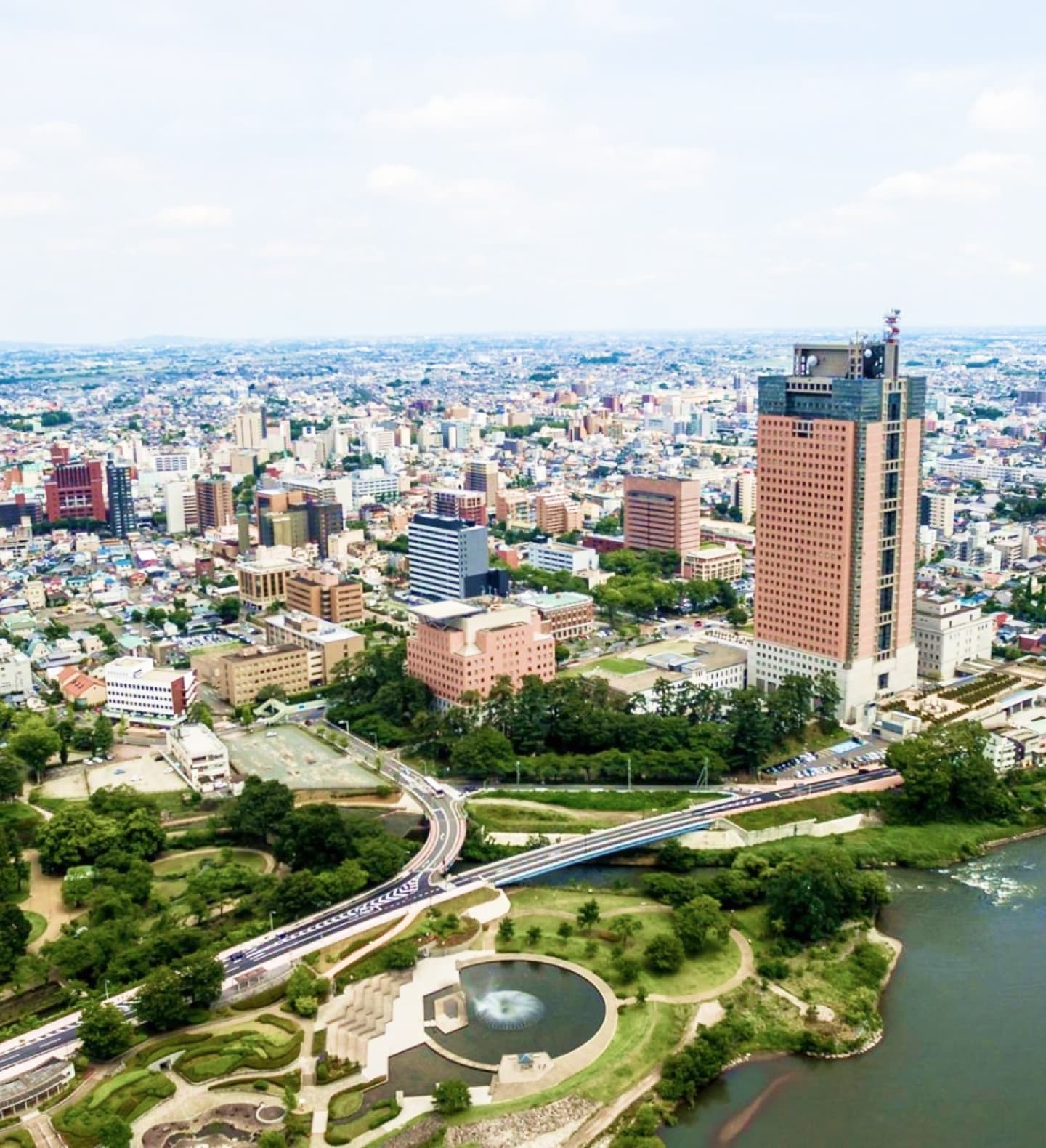
Gunma aims to take inspiration from the walkability, mixed-use zoning, and creativity-infused urban landscape of Portland, Oregon, along with the accessibility to green spaces and the sense of openness found in Melbourne, Australia. By reimagining the street experience, Gunma hopes to transform the main street into a space that interacts with the surrounding city in a new ways while becoming a community gathering point. While new mobility solutions, such as autonomous public transportation, are being introduced to address these challenges, there is still an urgent need to transform Maebashi’s downtown traffic flow.
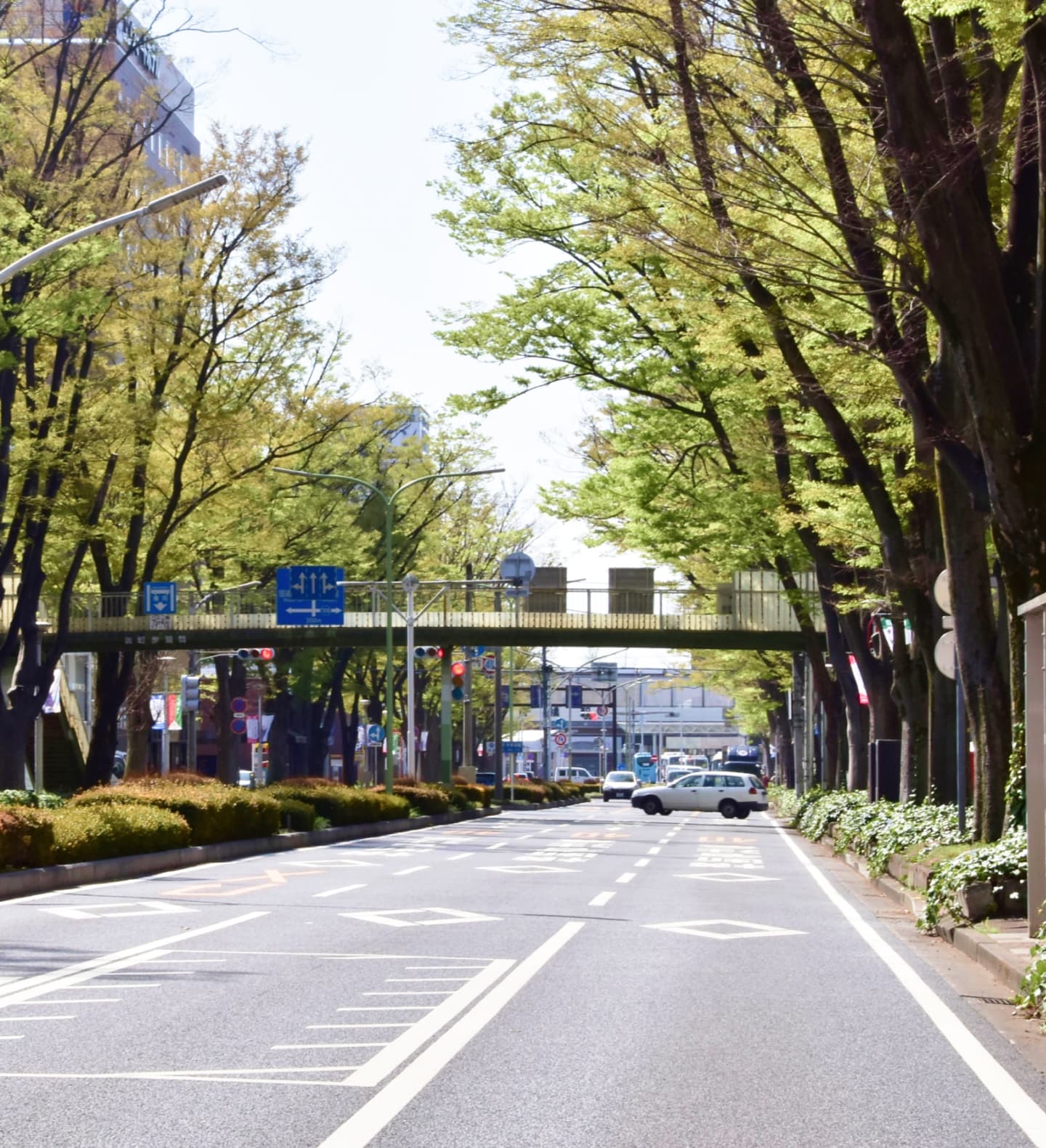
To realize a walkable, design-first downtown, Gunma prefecture invites local and international designers, architects, urbanists, and landscape architects to lead the redesigning of Maebashi into a global creative hub. This competition aims to collect innovative proposals for a forward-thinking, inspired “transit mall” design that is pedestrian-oriented while contributing to the city’s art-focused revival movement.
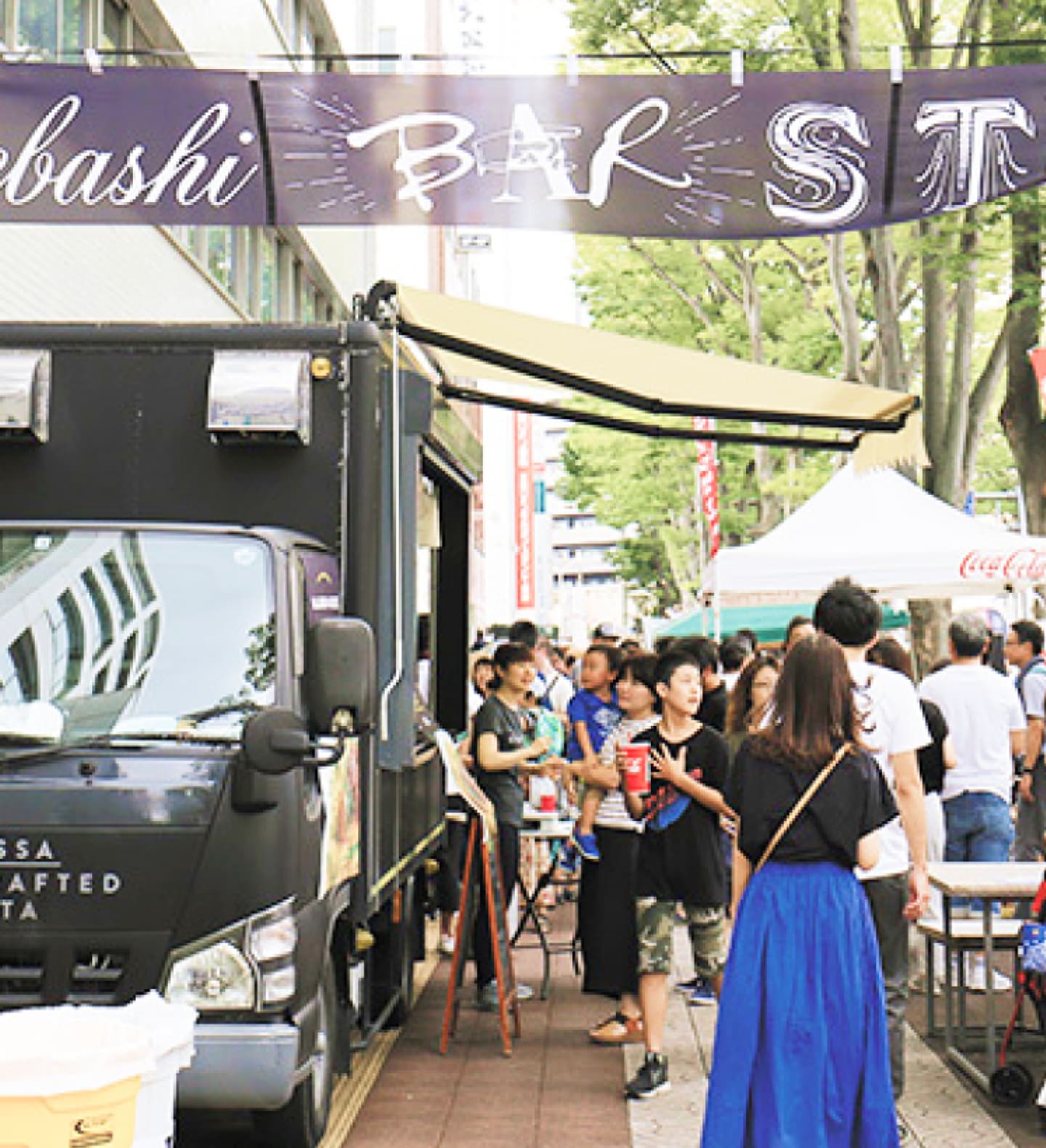

Outline of the Event
Competition Name
Maebashi Creative City
Prefectural Office–Maebashi Station
Urban Space Design
International Competition
OrganizerGovernor of Gunma Prefecture.
Competition Theme
“Design an innovative, creative
downtown
that prioritizes
sustainable urban infrastructure.”
-
Proposal 1
Road space design from
the prefectural office to
Maebashi Station. -
Proposal 2
Space design for
Prefectural
Citizens' Plaza.
Required Items
- Design concept showing the fundamental approach.
- Realization process for project implementation.
- Panoramic views and sketches of road spaces, Front Yard,etc. to visualize design ideas.(and more)
Requirements
- Proposals should utilize Maebashi City's unique regional resources, such as its culture and history,while addressing various challenges with a distinct local approach.
- Proposals should aim to create a walkable road space that prioritizes public transportation and pedestrians, where diverse individuals can gather, relax, and engage in activities.(and more)
- For other details, please refer to the recruitment guidelines.
Target Facilities
- Main street from Gunma Prefectural Office to Maebashi Station, about 1.5 km
- Prefectural Citizens' Plaza in front of Gunma Prefectural Office.
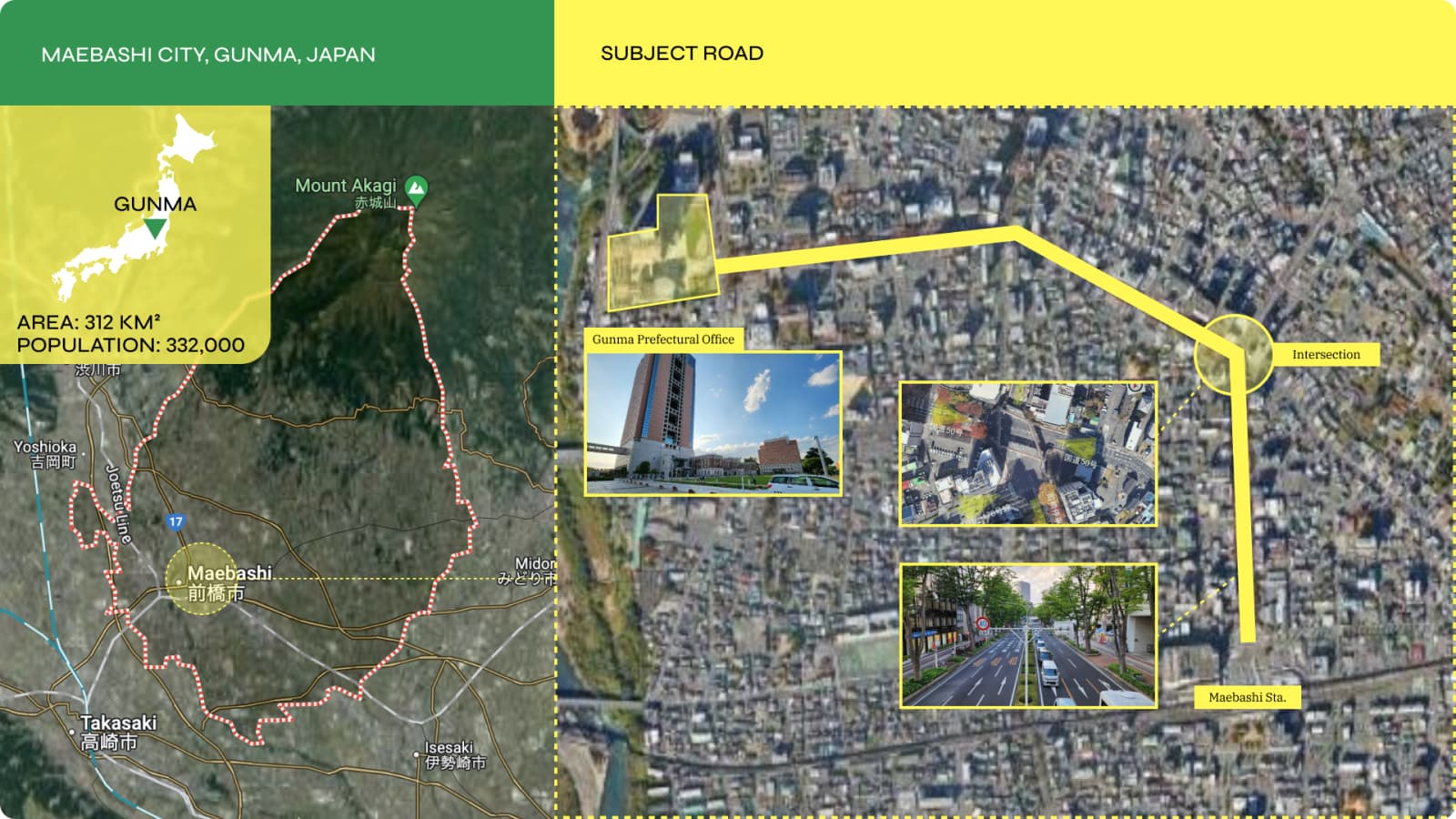
Application Period(Tentative)
2024.10.24
2024.11.22
Eligibility for Participation
Individuals or groups.
- However, at least one person with the necessary
qualifications must be assigned. - For other details, please refer to the recruitment guidelines.
Total Prize Money
29 (including tax) million yen
Best proposal prize
(1 person)
25 (including tax) million yen
- Best proposal prize money includes the 1 million yen
for those who pass the first screening.
Prize money for those
who
pass the first
screening(4 people)
1 (including tax) million yen
×
4 people
Schedule(Tentative)
Application Deadline
November 22,2024
First stage Proposal Deadline
December 13,2024
First stage Screening Results Announcement
Late December 2024
Final Screening Results Announcement
Late March 2025
- Schedule is subject to change.
For an overview of the competition,
please click here
Related Plans
Please check here for the competition leaflet.
After the Design Competition is over, you will need to register for Gunma Prefecture bidding qualifications before you can enter a contract for basic design. For details on registration, please click here.

Guidelines for Application
Please check the recruitment guidelines and download the necessary documents.
-
Guidelines for Application
November 15, 2024 Partially revised
- Reference ENG
Templates
Planned Registration of Participation
- Form 1-1-1: Planned registration form for individual corporations
- Form 1-1-2: Planned registration form for consortiums
- Form 1-2: Consortium Member Planned Registration Form
Questions
Declaration of Participation and Oath
- Form 3-1-1: Declaration of participation and oath for individual corporations(Updated on December 3, 2024)
- Form 3-1-2: Declaration of participation and oath for consortiums(Updated on December 3, 2024)
- Form 3-2: Consortium member declaration of participation and oath(Updated on December 3, 2024)
- Form 3-3: Application for Changes in Consortium Member Planned Registration
First-stage screening documents
- Form 4-1: Business results and engineer deployment system(November 5, 2024 Partially revised)
- Form 4-2: Engineer's career, etc.
Documents for the second Screening
Supplementary Materials
- Material 1: Proposal Area Map
- Material 2: Maebashi Creative City Prefectural Office to Maebashi Station Urban Space Design: Basic Design Work Contract Specifications(Some additions on February 4, 2025)
- Material 3: Current situation photograph (prefectural office to Maebashi Station)
- Material 4: Condition setting for Prefectural plaza
- Material 5: People flow analysis results(Some additions on November 22, 2024)
- Material 6: Needs of the community
- Material 7: Roadside entrances and surrounding road traffic restrictions
- Other: City Road 00-017, National Route 50, Prefectural Road Maebashi Station Line Road Register Map, Omote-machi Pedestrian Bridge Plans
- The CAD data for the entire proposed area
- The CAD data for the CitizensCitizens’Square
- The CAD data for the created space in Honmachi 2 Chome Five Way Intersection.
Application registration
Please fill in the application registration form and register.
Registration acceptance period
2024.10.24(Thu)
2024.11.22(Fri)
-
Application Form
※Registration for Preliminary Application is now closed
Submission Documents
- Form 1-1-1: Planned registration form for individual corporations
- Form 1-1-2: Planned registration form for consortiums
- Form 1-2: Consortium Member Planned Registration Form

First Screening
Declaration of Participation and Submitted for First Screening
Please submit the declaration of participation and Documents to be Submitted for First Screening using the form below, attaching the required documents.
The username and password required to log in to the form below will be sent to prospective applicants by email.
Registration acceptance period
2024.11.22(Fri)
2024.12.13(Fri)
-
Declaration of Participation and Submitted for First Screening Form
※The declaration of participation and submission for first screening has been closed.
Submission Documents
Declaration of Participation and Oath
- Form 3-1-1: Declaration of participation and oath for individual corporations(Updated on December 3, 2024)
- Form 3-1-2: Declaration of participation and oath for consortiums(Updated on December 3, 2024)
- Form 3-2: Consortium member declaration of participation and oath(Updated on December 3, 2024)
- Form 3-3: Application for Changes in Consortium Member Planned Registration
First-stage screening documents
- Form 4-1: Business results and engineer deployment system(November 5, 2024 Partially revised)
- Form 4-2: Engineer's career, etc.
- First proposal submission document (A2 size, 2 vertical pages)
Q&A
If you have any questions, please contact us using the form.
Registration acceptance period
2024.10.24(Thu)
2024.11.15(Fri)
-
Question Form
※Questions are closed
Submission Documents
- Form 2: Questions regarding recruitment guidelines
Answers
Answers to your questions are posted below.
- Scheduled for updates as needed.
Updated on November 20, 2024
Works that passed the first screening

Second Screening
Secondary screening submission
Submit secondary screening submission documents with necessary documents attached, using the form below.
The username and password to log in to the form below are the same as those used in preliminary screening submission.
Registration acceptance period
2025.2.10(Mon)
2025.3.10(Mon)
5:00 pm Japan time
-
Submitted for Second Screening Form
※Submission for second screening has been closed.
Submission Documents
- Form 5: Second Proposal Document(February 19, 2025 Font correction)
- Form 6-1 to 6-3: Estimated Project Cost Breakdown Table(Some additions on February 4, 2025)

Judging Committee
A Judging Committee is set up to performing judging of proposals, selection of the top proposer, etc. in the competition. Convening of the Judging Committee is as follows.
Convening of the Judging Committee
(Released prior to announcement of the second-round results)
Convening of the Judging Committee
(including deliberation contents)
- Proceedings of the first Judging Committee (March 22, 2024)
- Proceedings of the second Judging Committee (October 4, 2024)
- SProceedings of the third Judging Committee (December 27, 2024)
- Proceedings of the fourth Judging Committee (March 22, 2025)
Guidelines and Regulations
The guidelines and regulations for this competition,
as approved by the Judging Committee, are available below.

Local Coordination
Maebashi City Center Creative City Promotion Council
In collaboration with Gunma Prefecture, the city of Maebashi has taken the lead in establishing this council. Its aim is the operation of comfortable, safe public transportation adapted to new means of mobility such as MaaS, as well as the creation of walkable road spaces focused on pedestrians and integrated with cityscape designs, along and near the Zelkova tree-lined street leading from JR Maebashi Station to Gunma Prefectural Office.
Through the council, the city will strive to form consensus with local residents.
Summary of the Council proceedings
・Summary of the Council proceedings
* Under preparation
Urban Planning Conference
In order to reach consensus with people in areas not participating in the Creative City Promotion Council, urban planning meetings are being held to solicit opinions.
First Urban Planning Conference
We conducted a questionnaire survey and an open house concerning
"Urban Planning between the Prefectural Office and Maebashi Station."
Second Urban Planning Conference
(September 13 and 15, 2024)
We conducted reports on the outcomes of the questionnaire survey and open house, and briefings on matters including considerations demanded by the community.
Third Urban Planning Conference
(January 13 to 26, 2025)
A public exhibit of the five works that passed the first screening was held to solicit comments for use as reference in secondary proposals and secondary screening.
We would like to express our gratitude for the many (115) comments and opinions received.
Maebashi Creative City Urban Planning WEEK 2025 SUMMER
From August 20 (Wed) to August 24 (Sun), 2025, we held the Maebashi Creative City Urban Planning WEEK 2025 SUMMER. Many participants joined and shared their ideas on the future of Maebashi and urban planning initiatives. Please see the summary of the results below:
Local Briefing on the Maebashi Creative City Initiative
To share detailed information about the Maebashi Creative City Initiative with local residents, the City of Maebashi held a series of local briefings from Sunday, November 9 to Thursday, November 13.
A summary of the results is available below.

CONTACT
Please contact us using the form.
Important Notices
Depending on the content of your inquiry, we may not be able to reply.
Please be aware of this before making your inquiry.
Below is a Q&A of frequently asked questions.
Please check before contacting us.
-
Frequently asked questions Q&A
Posted on 2024.11.21

MOVIE
The International Competition Symposium video
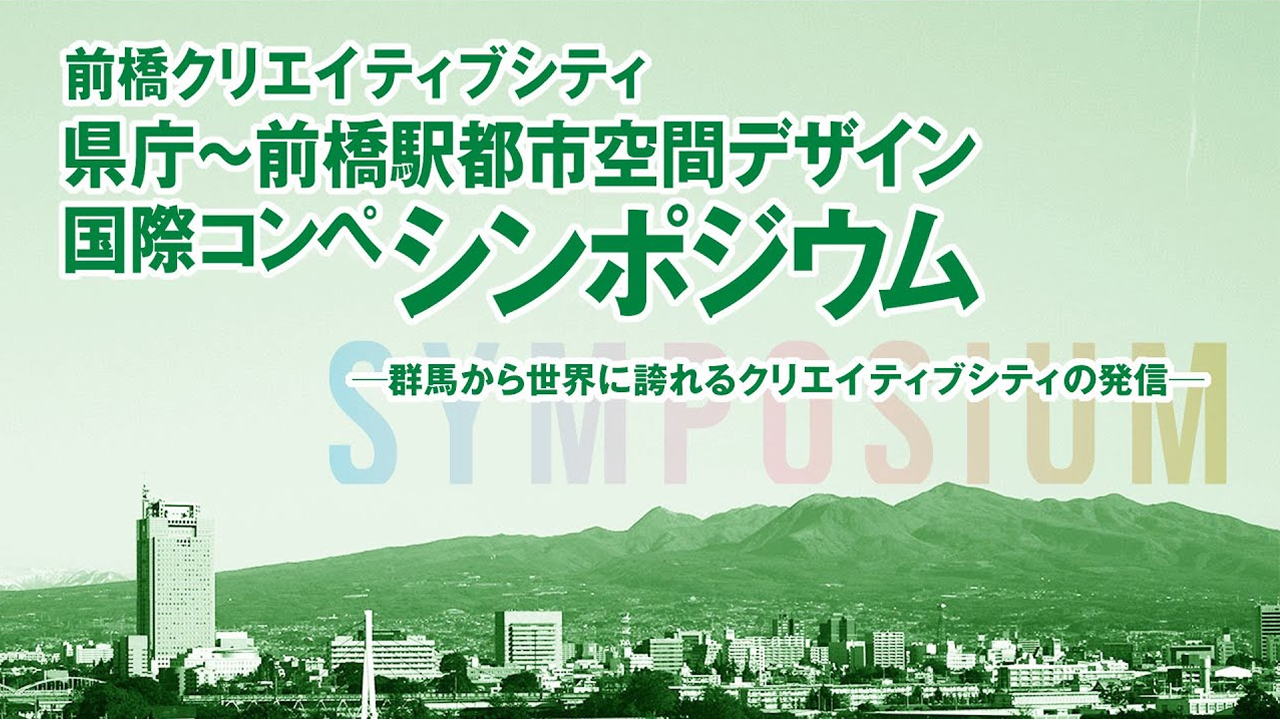
You can play from the specified location using the links below.
- Opening Remarks (approx. 14 minutes)
- Part 1: Presentation of the Grand Prize-winning Proposal (approx. 25 minutes)
- Part 2: Panel Discussion (approx. 80 minutes total)
- (1)Introduction of Panelists (approx. 4 minutes)
- (2)Discussion I: Urban Development Initiatives in Maebashi (approx. 15 minutes)
- (3)Discussion II: Significance of the International Competition and the Grand Prize-winning Proposal (approx. 12 minutes)
- (4)Discussion III: Creating a Future-Oriented and Globally Admired Innovative City (approx. 30 minutes)
- (5)Discussion IV: Proposals for Realizing the Vision for the City (approx. 12 minutes)
- (6)Closing Reflections on the Panel Discussion (approx. 7 minutes)


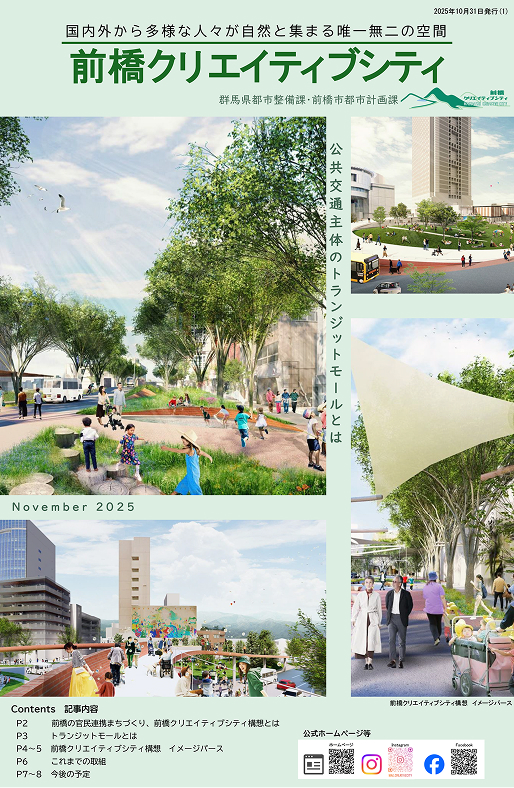


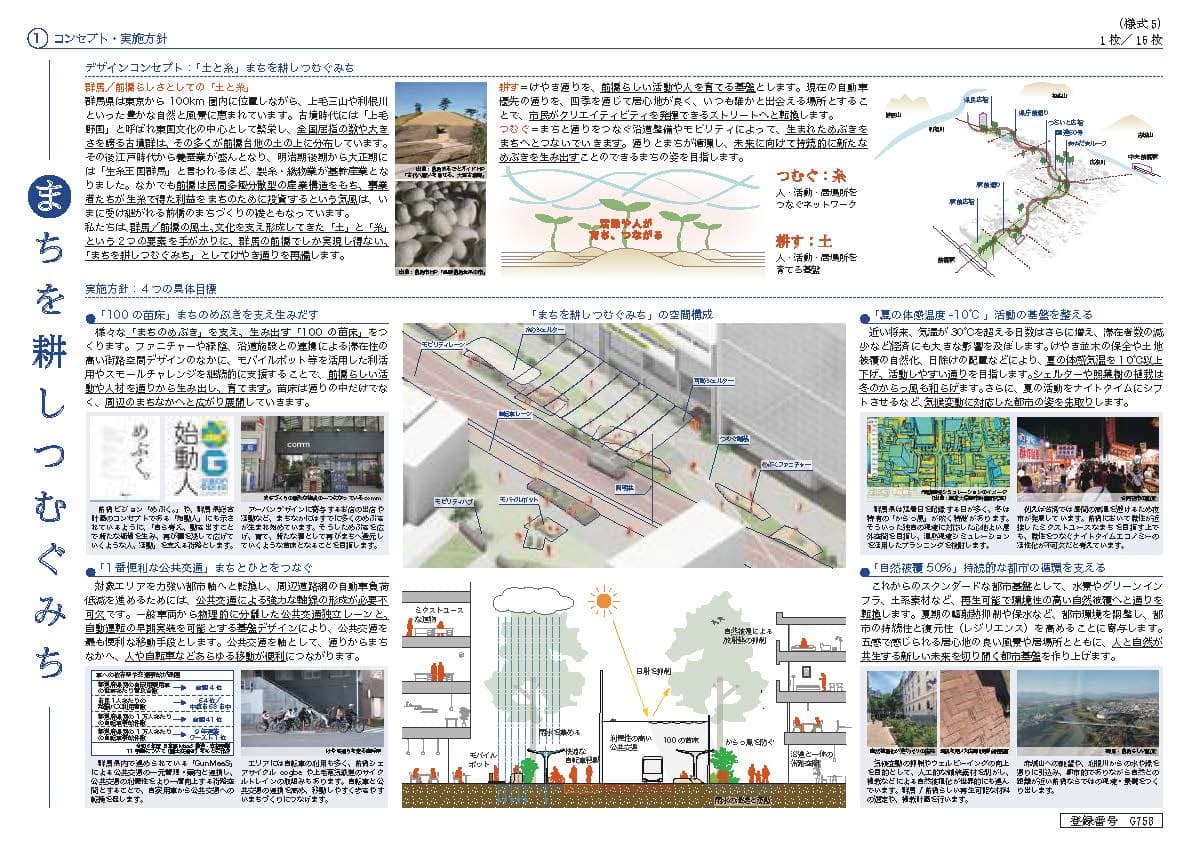















2025.12.1 Posted
Notice Concerning Maebashi Creative City Urban Planning WEEK 2025 WINTER
Gunma Prefecture is advancing the Maebashi Creative City Initiative, which aims to reorganize the main street between the Prefectural Office and Maebashi Station into a walkable urban space focused on public transportation and pedestrians, thereby creating vibrancy and enhancing the value of the area. In FY2025, the prefecture is moving forward with basic urban-space design work to develop this concept into concrete plans.
Following Maebashi Creative City Urban Planning WEEK 2025 SUMMER held in August, we will host Urban Planning WEEK 2025 WINTER, an opportunity to discuss and envision the future of Maebashi together with the community.
We warmly invite you to join us in thinking about—and shaping—the future of Maebashi.
[Open House Format]
Session 1: 10:00 to 11:30
Session 2: 13:00 to 14:30
Please apply via the form below by 17:00 on Wednesday, December 10.